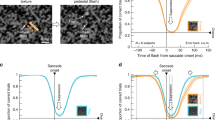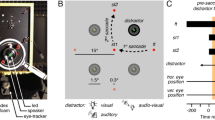Abstract
There is now considerable evidence that space is compressed when stimuli are flashed shortly before or after the onset of a saccadic eye movement. Here we report that short intervals of time between two successive perisaccadic visual (but not auditory) stimuli are also underestimated, indicating a compression of perceived time. We were even more surprised that in a critical interval before saccades, perceived temporal order is consistently reversed. The very similar time courses of spatial and temporal compression suggest that both are mediated by a common neural mechanism, probably related to the predictive shifts that occur in receptive fields of many visual areas at the time of saccades.
This is a preview of subscription content, access via your institution
Access options
Subscribe to this journal
Receive 12 print issues and online access
$209.00 per year
only $17.42 per issue
Buy this article
- Purchase on Springer Link
- Instant access to full article PDF
Prices may be subject to local taxes which are calculated during checkout




Similar content being viewed by others
References
Ross, J., Morrone, M.C., Goldberg, M.E. & Burr, D.C. Changes in visual perception at the time of saccades. Trends Neurosci. 24, 113–121 (2001).
Matin, L. in Handbook of Sensory Physiology vol. VII/4: Visual Psychophysics (eds. Jameson, D. & Hurvich, L.M.) 331–380 (Springer-Verlag, Berlin, 1972).
Honda, H. Perceptual localization of visual stimuli flashed during saccades. Percept. Psychophys. 45, 162–174 (1989).
Ross, J., Morrone, M.C. & Burr, D.C. Compression of visual space before saccades. Nature 386, 598–601 (1997).
Morrone, M.C., Ross, J. & Burr, D.C. Apparent position of visual targets during real and simulated saccadic eye movements. J. Neurosci. 17, 7941–7953 (1997).
Lappe, M., Awater, H. & Krekelberg, B. Postsaccadic visual references generate presaccadic compression of space. Nature 403, 892–895 (2000).
Kaiser, M. & Lappe, M. Perisaccadic mislocalization orthogonal to saccade direction. Neuron 41, 293–300 (2004).
Duhamel, J.R., Colby, C.L. & Goldberg, M.E. The updating of the representation of visual space in parietal cortex by intended eye movements. Science 255, 90–92 (1992).
Nakamura, K. & Colby, C.L. Updating of the visual representation in monkey striate and extrastriate cortex during saccades. Proc. Natl. Acad. Sci. USA 99, 4026–4031 (2002).
Kusunoki, M. & Goldberg, M.E. The time course of perisaccadic receptive field shifts in the lateral intraparietal area of the monkey. J. Neurophysiol. 89, 1519–1527 (2003).
Leon, M.I. & Shadlen, M.N. Representation of time by neurons in the posterior parietal cortex of the macaque. Neuron 38, 317–327 (2003).
Janssen, P. & Shadlen, M.N. A representation of the hazard rate of elapsed time in macaque area LIP. Nat. Neurosci. 8, 234–241 (2005).
Deubel, H. & Schneider, W.X. Saccade target selection and object recognition: evidence for a common attentional mechanism. Vision Res. 36, 1827–1837 (1996).
Gersch, T.M., Kowler, E. & Dosher, B. Dynamic allocation of visual attention during the execution of sequences of saccades. Vision Res. 44, 1469–1483 (2004).
Stevenson, S.B., Volkmann, F.C., Kelly, J.P. & Riggs, L.A. Dependence of visual suppression on the amplitudes of saccades and blinks. Vision Res. 26, 1815–1824 (1986).
Ridder, W.H., III & Tomlinson, A. Suppression of contrast sensitivity during eyelid blinks. Vision Res. 33, 1795–1802 (1993).
Rose, D. & Summers, J. Duration illusions in a train of visual stimuli. Perception 24, 1177–1187 (1995).
Enns, J.T., Brehaut, J.C. & Shore, D.I. The duration of a brief event in the mind's eye. J. Gen. Psychol. 126, 355–372 (1999).
Tse, P., Intriligator, J., Rivest, J. & Cavanagh, P. Attention and the subjective expansion of time. Percept. Psychophys. 66, 1171–1189 (2004).
Titchener, E.B. Lectures on the Elementary Psychology of Feeling and Attention (MacMillan, New York, 1908).
Reeves, A. & Sperling, G. Attention gating in short-term visual memory. Psychol. Rev. 93, 180–206 (1986).
Sperling, G. & Weichselgartner, E. Episodic theory of the dynamics of spatial attention. Psychol. Rev. 102, 503–532 (1995).
Shore, D.I., Spence, C. & Klein, R.M. Visual prior entry. Psychol. Sci. 12, 205–212 (2001).
Park, J., Schlag-Rey, M. & Schlag, J. Spatial localization precedes temporal determination in visual perception. Vision Res. 43, 1667–1674 (2003).
Bridgeman, B., Hendry, D. & Stark, L. Failure to detect displacement of visual world during saccadic eye movements. Vision Res. 15, 719–722 (1975).
McConkie, G.W. & Zola, D. Is visual information integrated across succesive fixations in reading? Percept. Psychophys. 25, 221–224 (1979).
Henderson, J.M. & Hollingworth, A. Global transsaccadic change blindness during scene perception. Psychol. Sci. 14, 493–497 (2003).
Niemeier, M., Crawford, J.D. & Tweed, D.B. Optimal transsaccadic integration explains distorted spatial perception. Nature 422, 76–80 (2003).
Burr, D.C. & Morrone, M.C. Temporal impulse response functions for luminance and colour during saccades. Vision Res. 36, 2069–2078 (1996).
Yarrow, K., Haggard, P., Heal, R., Brown, P. & Rothwell, J.C. Illusory perceptions of space and time preserve cross-saccadic perceptual continuity. Nature 414, 302–305 (2001).
Park, J., Schlag-Rey, M. & Schlag, J. Voluntary action expands perceived duration of its sensory consequence. Exp. Brain Res. 149, 527–529 (2003).
Yarrow, K. & Rothwell, J.C. Manual chronostasis: tactile perception precedes physical contact. Curr. Biol. 13, 1134–1139 (2003).
Hodinott-Hill, I., Thilo, K.V., Cowey, A. & Walsh, V. Auditory chronostasis: hanging on the telephone. Curr. Biol. 12, 1779–1781 (2002).
Haggard, P., Clark, S. & Kalogeras, J. Voluntary action and conscious awareness. Nat. Neurosci. 5, 382–385 (2002).
Gibbon, J. Scalar expectancy theory and Weber's Law in animal timing. Psychol. Rev. 84, 279–325 (1977).
Santoro, L., Burr, D. & Morrone, M.C. Saccadic compression can improve detection of Glass patterns. Vision Res. 42, 1361–1366 (2002).
Ross, J. in Department of Psychology Research Report 4 (University of Western Australia, Perth, 1972).
Libet, B., Wright, E.W., Jr., Feinstein, B. & Pearl, D.K. Subjective referral of the timing for a conscious sensory experience: a functional role for the somatosensory specific projection system in man. Brain 102, 193–224 (1979).
Eagleman, D.M. & Sejnowski, T.J. Motion integration and postdiction in visual awareness. Science 287, 2036–2038 (2000).
Carpenter, R.H.S. Movement of the Eyes (Pion, London, 1988).
Acknowledgements
We acknowledge relevant previous work in our laboratory by M.R. Diamond. This research was funded by grants from the Australian National Health and Medical Research Council and the Australian Research Committee and by the Italian Ministry of Education, Universities and Research (Progetti di Ricerca di Interesse Nazionale).
Author information
Authors and Affiliations
Corresponding author
Ethics declarations
Competing interests
The authors declare no competing financial interests.
Rights and permissions
About this article
Cite this article
Morrone, M., Ross, J. & Burr, D. Saccadic eye movements cause compression of time as well as space. Nat Neurosci 8, 950–954 (2005). https://doi.org/10.1038/nn1488
Received:
Accepted:
Published:
Issue Date:
DOI: https://doi.org/10.1038/nn1488
This article is cited by
-
Dissociation of perception and motor execution of lower limb in multi-directional movements
Scientific Reports (2023)
-
Top-down determinants of the numerosity–time interaction
Scientific Reports (2023)
-
Visual timing-tuned responses in human association cortices and response dynamics in early visual cortex
Nature Communications (2022)
-
Magnetic resonance-based eye tracking using deep neural networks
Nature Neuroscience (2021)
-
A sensory memory to preserve visual representations across eye movements
Nature Communications (2021)



